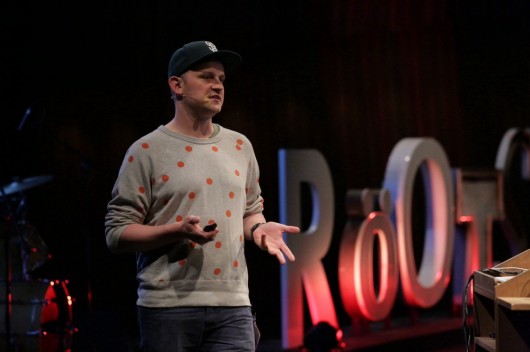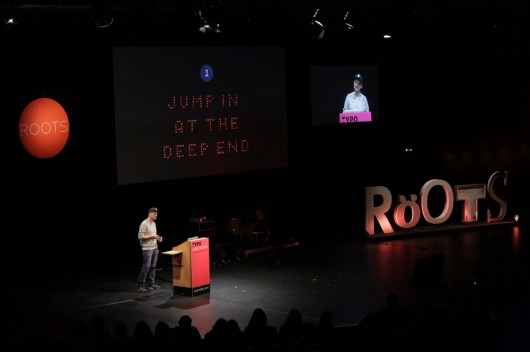Two days after the presentation at TYPO Berlin »Play« in 2006, Daniel quit his job and founded Stupid Studio. Now, eight years later he shared “13 Stupid Tips” for designers on how to keep work playful – going back to the “roots” of why he started the studio in the first place. Despite having to worry about real business needs like salaries, veggie options and internet connections, Gjøde still believes “If you can spend each day doing what you like to do, you no longer work.”

Daniel Gjøde
Founding Partner & Creative Director (Copenhagen, Denmark)
I'm 36. Creative Director, Windsurfer and Father.
I founded Stupid Studio in 2006 – an independent digital creative agency set out to do stuff for good companies, who believe they can change stuff to the better, funnier, or simply more comfortable.
I’ve been working with motion graphics and digital concepts within culture and television for longer than I can reasonably remember, and it has given me a user-centered approach to what I do. It's all about creating something of value, that means something to people.
I've appeared on many conference platforms waving my arms enthusiastically and shouting stuff about the stuff we do, and I'm a proud board member of Design Denmark and the Advisory Board of the Danish School of Media & Journalism, where I ruthlessly decide the future of young students (usually while laughing frantically).
Recently I pulled the plug and went travelling with my family for 5 months. To get away. To focus and find myself again. To find out what matters.
I never let the truth get in the way of a good story.
Tip 1: Jump in at the Deep End
The axiom “do one thing every day that scares you” is key as a professional designer. It’s important to fail and fail a lot, “fail faster, but don’t let it kill you.” Don’t view your audience as stupid and do place value over grabbing attention.
Tip 2: Start at the Beginning
Recognize crafting is part of the design. Encourage your colleagues to make art, encourage your clients to get to the heart of what they want through going through an exploration process (at Stupid it’s called the “Bipolar Emotional Response Test.” Using the example of Stupid’s work with the Odense International Film Festival, Gjøde showed how creating a dynamic identity system can harken back to original elements, but still move and be playful.
Tip 3: Love the Process
“What fascinates me is not just the outcome, but the beauty of the process,” said Gjøde, emphasizing that the process should be playful. Showing examples of design you can hold in your hand – sketches and discarded tactical projects from the Stupid staff – he declared that “Creativity is messy and we should accept that.”
He used the example of making a 13 out of the B in the Brandts campaign, as well as other visual elements, that came about during the design process.
Tip 4: Have Fun
Clearly the slide meant for a cat gif (“It’s not a presentation without cats”), Gjøde underlined the importance of having fun in the workplace. “We use the amount of laughter at the office as a way of measuring people’s well-being.” This has not always been the case at Stupid and in the next tip, Gjøde shared how he learned the hard way.
Tip 5: Culture Beats Strategy
Micromanagement and losing a sense of play and fun leads to “culturally bankruptcy”, Gjøde shared a personal story of how through burn out of management and staff, Stupid learned to value culture and people over business strategy.
Tip 6: Only Hire the Very Best
Approaching new business with the rule “never take on more jobs than we can sustain,” Gjøde can keep his talent happy. Also, promoting interns to full-time employees and hiring young people who are more open to new ideas.
Tip 7: Trust Your Gut
“Almost always that gut feeling is about chemistry between people,” Gjøde emphasized.
Tip 8: Never Pitch. Never.
Breaking his own rule to pitch to a client after successfully completing a successful integrated campaign, Gjøde shared the all-too-familiar tale of then not getting the next campaign after spending 120 hours on the pitch. Event though he still has a good relationship with that client, he reminded that among many things, pitches focus on winning over the client, not on solving the problem.His call to action, “let’s make a collective decision, today, as an industry, that we will never pitch again” was met with hoots and hollers from the audience.
Tip 9: Train your creatives.
Using the Picasso quote “Every child is an artist. The problem is how to remain an artist when you grow up,” Gjøde discussed that we’re not “left” or “right” brained and we all can be creative.
Tip 10: Make the Rules
Be very good at explaining why solution is the right one for the client. It’s the creative’s responsibility to differentiate between emotional and rational responses. Have rehearsals with your clients. Distilling rules to clients give us something of value.
Tip 11: Invest in People
Involve people in the heart of your business. Remember that time is greater than money and respect work/life balance. Stupid spends one day a month talking about how things are working and also gets out of the office together. Evaluate projects when they end and learn from them. Encourage personal projects. Remember “there’s no strings attached to people.”
Tip 12: Say No
“I’m a time optimist,” Gjøde said, showing a pie chart in which a small sliver was marked “Doing Stuff I Love.” It’s a reminder, he underscored, to “prioritize the play, otherwise it won’t happen.”
Tip 13: Take Time Off
Again, something we all should be reminded of from time-to-time. Whether it’s turning off the phone for an hour, going outside for a day, or going away for a week, Gjøde reminded the audience that this is a key part of creativity. Then he announced that in two weeks he’ll be “going apeshit” with this concept, taking eight months off to reconcile eight years of the agency. You can follow his adventures @danielgjoede on Twitter.
Text – Meghan Arnold






















